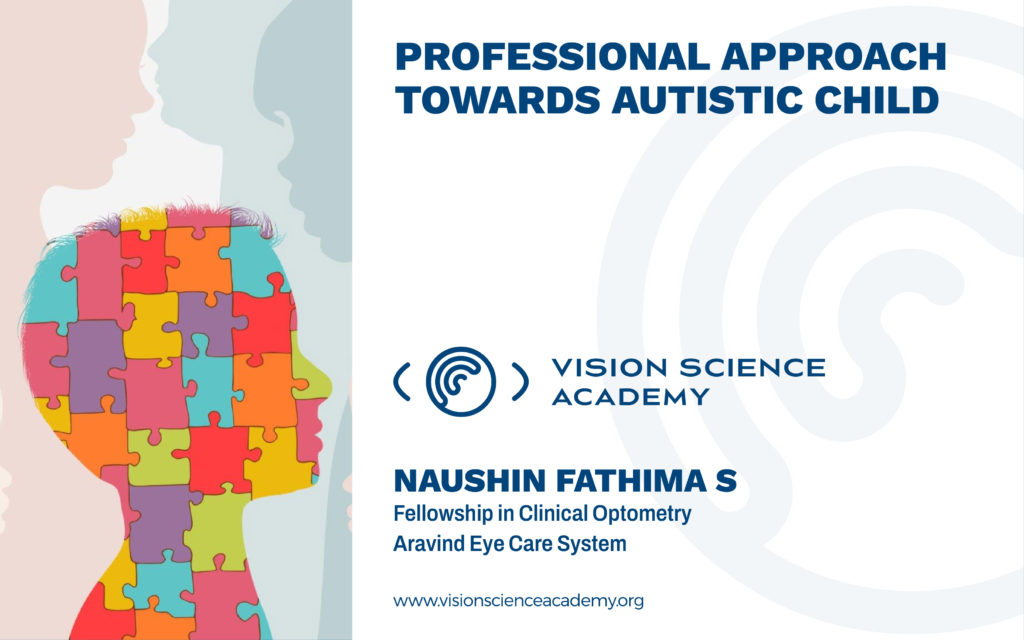Naushin Fathima S, B. Optom
Fellowship in Clinical Optometry, Aravind Eye Care System, Chennai, India
Autism:
The defining feature of autism is the presence of a distinctive impairment in the nature and quality of social and communicative development. They have difficulty with imitation, imaginative play, and non-verbal communication (eye contact).(1)
Causes:
- Genetic cause – Hereditary, Genetic mutation, Down Syndrome, Fragile X syndrome, Rett syndrome.
- Environmental cause – Maternal obesity, premature birth, fever during pregnancy, exposure to pesticides during pregnancy, depletion of neurotransmitters.
- Idiopathic.
Signs:
The repetitive and restricted behaviour such as
- Sensory feature:
- Hypersensitivity to auditory, tactile, visual, and olfactory.(1)
- Low intensity exposure can result in distress and discomfort.(1)
- Delayed speech, difficulty in eye contact
- Motor feature:
- Rigid body
- Compulsive behaviour – Ordering and Rearranging.(1)
- Ritualistic- Pattern walking and repetitive action like on and off lights.(1)
- Stereotypic- Hand and arm flapping, toe walking, repetitive jumping, head shaking, weaving and side to side rocking.(1)
Aggression and self-injurious behaviour.
Figure 1: Signs of autistic child
[Image courtesy- https://www.momjunction.com/articles/children-with-autism-spectrum-disorder-types-causes-treatment_00780471/]
Assessment:
Parents, family members, physicians, and early childhood teachers play a vital role in monitoring and screening the developmental milestones of children from birth to 5 years of age.
Table 1: Assessment of autistic children
| Functional Assessment | Other Routine Assessment |
|---|---|
|
|
Management
- Family centred support is a combination of emotional, educational, and social development.
- Professional Therapy
- Functional Therapy – such as Behavioural, Occupational, Speech, Auditory and Vision Therapy will help in the development of children.
- Pharmacotherapy – depends on behavioural abnormalities (symptoms) and underlying biochemical (depletion of certain neurotransmitters).The goal of psycho pharmacotherapy is to correct both with an effective.(2)
Figure 2: Simple tips for managing the autistic child
[Image courtesy-https://www.artedguru.com/home/asd-autism-spectrum-disorder]
Professional approach:
- Observing the child and collecting information in the area of interest.
- Creating a bond between therapist and child by being playful, familiar, focusing on their interests.
- To work, plan and organise the visual, realistic, and work difficulties of the child.
- Keeping the child in the comfort zone is more important.
- Approaching a child with permissive manner.(3)
Optometrist role:
- Optometry role is not only performing refraction but also prescribing the Compensatory glass prescription.
- Also assessing the visual acuity, extraocular muscles, pursuits, fixation, saccades, accommodation, and convergence.
- Assessing the higher level of visual function such as eye and hand coordination, visual auditory response, visual perception.(4)
References:
- Stone-MacDonald, A., Cihak, D.F., & Zager, D. (Eds.). (2016). Autism Spectrum Disorders: Identification, Education, and Treatment (4th ed.). Routledge. https://doi.org/10.4324/9781315794181
- Moldin, S.O., & Rubenstein, J.L.R. (Eds.). (2006). Understanding Autism: From Basic Neuroscience to Treatment (1st ed.). CRC Press. https://doi.org/10.1201/9781420004205
- (2022, October 17). Neural Engineering Techniques for Autism Spectrum Disorder, Volume 2 – 1st Edition. https://www.elsevier.com/books/neural-engineering-techniques-for-autism-spectrum-disorder-volume-2/suri/978-0-12-824421-0
- Schulman, R. (2020, June 13). Optometry’s Role in Autism Spectrum Disorders – VisionHelp. VisionHelp. https://visionhelp.com/autism-sensory-integration/optometrys-role-in-autism-spectrum-disorders/
